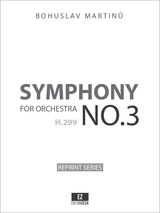
Hans Kindler was one of the most brilliant and dedicated musicians of his generation. Born in Rotterdam in 1892 and trained at the city’s conservatory, Kindler emigrated to the United States in 1914 to become Principal Cellist of the Philadelphia Orchestra. After serving in that distinguished ensemble for six years, he followed a solo career until choosing in 1927 to devote himself to conducting; the following year he led the premiere of Stravinsky’s ballet Apollon Musagète in Washington, D.C. Realizing that the nation’s capital did not have an adequate permanent orchestra, four years later, at the height of the Great Depression, he founded the National Symphony Orchestra. The venture was a success, and Kindler became an influential advocate of contemporary composers during his seventeen years as the ensemble’s music director.
Early in 1945, when World War II was entering the final phase of its exhausting course, Kindler commissioned Bohuslav Martinů to write a work for the NSO. He could only offer $200 (of his own money) for the job, however, so a short, one-movement piece was agreed upon. Martinů chose to write a high-energy scherzo for Kindler and completed the score during the first two weeks of September (“lots of work for little money,” he grumbled to a friend). He titled the piece Thunderbolt P-47, a tribute to both the pilots of the U.S. Air Force and to Republic Aviation’s eponymous plane, America’s largest, heaviest, most expensive, most durable and most effective single-engine fighter-bomber of World War II. Martinů’s Thunderbolt P-47 follows the traditional tripartite form of the scherzo (A–B–A), though its style embodies a decidedly
modern musical evocation of the speed and power of military aviation: the muscular outer sections are driven by strong, repetitive rhythms and full scoring, while the central episode is rather dance-like in mood and lighter in texture.
- Difficulty:
- Intermediate/Advanced
- Instrumentation:
- Picc, 2Fl, 3Ob, 3Cl, 3Bsn, 4Hn, 3Tpt, 3Tbn, Tba, Timp, Perc(3), Strings
- Duration:
- 10 to 11 minutes
- Set of Parts:
- Includes Strings count 4.4.3.3.2






